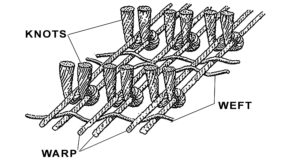
Once there was and twice there wasn’t…
they take you places full of meaning
As I sat upon his magic carpet, I reflected wise fools seek truth while shrewd artisans sift for meaning. King Solomon was so focused on building his temple that he discarded this carpet—a gift from the Queen of Sheba honoring his wisdom. Give the king his due: truth endures, while the transitory is toil.
But I’d rather fly than walk.



If we do not tell its stories, the city unravels.
They are only as strong as the warp and weft that holds the beautiful knot-work.
The city is the context –from the Latin “with textile”–for a vast number of simultaneous stories (Childs, 2008; Rogers, 2013; Filep, Thompson-Fawcett, & Rae, 2014; Bakshi, 2014.) The threads that make up that textile are themselves the threads of previous stories that form the warp and weft of the narrative infrastructure. Media ties into this infrastructure and expresses new stories much as the knots of a rug display a pattern. Most media studies focus on the macro pattern expressed by the knotting, but offer only token reference to the underlying structure.
This is an example of a worn rug that has lost its knot-work and exposed the weft in one location, and the underlying structure destroyed in another area. If the city could be lifted up by the narrative infrastructure—as artistically suggested below—presumably abandoned urban space would be left behind.

Could urban change professionals use these gaps as opportunity-zones to propose projects that might mend these parted strands of community narrative? Based on the mapped community stories of a city, areas that fall through these holes be presumed to be low in local sentiment. Community resistance to renewal and redevelopment is likely lower where people do not tell stories.
The converse is also true: if stories are not told about a neighborhood, there won’t be strength to resist change to the warp and weft. All great works crumble, and all threads unravel. So we must follow the example of Odysseus’s wife Penelope’s example: ever be unraveling and reweaving our beautiful works. If we do not tell its stories, the city unravels. Tell the meaningful stories!
References:
Bakshi, A. (2014) ‘Urban Form and Memory Discourses: Spatial Practices in Contested Cities’, Journal of Urban Design, pp. 189–210. doi: 10.1080/13574809.2013.854696.
Childs, M. C. (2008) ‘Storytelling and urban design’, Journal of Urbanism: International Research on Placemaking and Urban Sustainability, 1(2), pp. 173–186. doi: 10.1080/17549170802221526.
Rogers, D. (2013) ‘The Poetics of Cartography and Habitation: Home as a Repository of Memories’, Housing, Theory and Society, 30(3), pp. 262–280. doi: http://dx.doi.org/l 0.1080/14036096.2013.797019 .
Thompson-Fawcett, M. and Rae, M. (2014) ‘Built Narratives’, Journal of Urban Design. Taylor & Francis, 19(3), pp. 298–316. doi: 10.1080/13574809.2014.890043.
